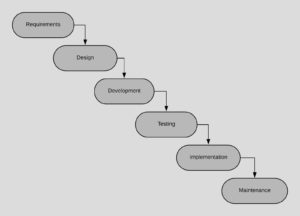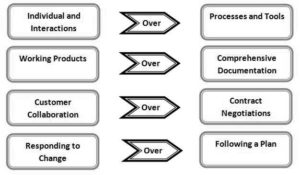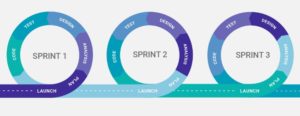Software projects’ success depends on various aspects including the choice of the development approach.
Waterfall and Agile are the most powerful SDLC methodologies. On the eve of the new 2020, these approaches are still considered as the most popular and relevant; they dictate their rules to software developers and decide what real tendencies are. Although, in fairness, it is worth noting that Agile software development is a few steps ahead.
“Which one to choose?” is the frequent question development teams might have. Both are mature approaches to software development; however, these SDLC models have essential differences in several aspects. Let’s take a closer look at what Agile and Waterfall methodologies are, defining their pros and cons.
Contents
All about Waterfall
We can fairly name Waterfall the first modern methodology related to large software development and systems analysis. Winston W. Royce developed it in 1970 as a concept for transforming a risky development process into a linear process.
Waterfall includes 6 steps: planning, analysis, design, implementation, verification, and maintenance.
According to the Waterfall methodology, you have to follow through these stages of the project development and every stage must be finished before you move on to the next one.
- Planning means identifying project requirements and all the data you’ll need for your project. To plan effectively, you will need to do careful research, defining the target market and customers.
- During the Analysis stage, you document the design you are going to follow. In fact, you compose consistent documentation for your team.
- The Design stage comes due after reviewing and approving the requirements. You prepare for work and your team members are focused on what the product and what the outcome will look like.
- The Implementation stage is about where the work begins. You gather all the data from the previous stages and begin working on creating a successful product/service. By this time, you should have a clear view of your goals and how you’re going to get them.
- The Verification stage is the opportunity for testers to identify any problems or challenges with the product. If serious defects are founded, you can go back to some steps to find its origins. You fix them and note down areas where improvements can be made.
- If everything goes smoothly, then everything is on track. According to the ideal option, your product should be complete and ready to launch. The Maintenance stage means checking again potential errors, optimizing all capabilities and going live. Customers may come across new issues you hadn’t accounted for when they start using the product. That is why it is crucial to track testing the product constantly.

Waterfall advantages: Why they are still choosing the method?
- The method seems advantageous for managing dependencies.
- All software development phases do not require customer involvement.
- The method performs exceptionally well for small-scale projects with easily understandable requirements.
- Different team members are able to focus on different tasks, depending on the ongoing project phase.
- Well documented processes.
- Ease of management as every phase has a distinct review process and deliverables.
- Waterfall proposes faster delivery of the product.
- Straightforward planning, as customers and developers agree early about what and how to develop.
- As the full scope of the task is known beforehand, the progress can be evaluated easily.
- Waterfall suits projects where there is a need for multiple software components to be designed for integration with some external systems.
Waterfall disadvantages: Why it is time to say goodbye to this approach
- There can be many bugs (as tests start only when the project development is over).
- Waterfall looks less effective if the requirements are not clear at the beginning.
- No way to accommodate changes made later during the process.
- Waterfall does not provide customers with a clear picture of what they can expect as the end.
Why professionals choose Waterfall
Waterfall can be suitable for bigger enterprises whose finished product is usually its final version. For example, construction, healthcare, food industry, etc.
Companies consider using the Waterfall approach if:
- Their projects have small time-frames, time, and budget.
- They are working on a project with remote workers or with the customers, they do not communicate frequently with.
- The customers of their projects are not hands-on involved.
All about Agile
The deep world of Agile methodology is about iteration and defining what works and what does not.
Agile is based on the 12 Agile principles and 4 values described in the Manifesto for Agile Software Development:

The Agile approach looks much easier than Waterfall. The methodology iterates based on the customers’ feedback and prioritizes a high level of their involvement throughout the project.
There are different approaches to Agile best practices but the core sense of the methodology boils down to these steps:
- To plan
- To build
- To launch
- To learn
- To repeat
The planning stage means that you get an overall sense of what you’re building. You plan the customers’ vision when starting a new project, do some research, understand customers’ needs and struggles.
At the next stage, you build experiments, list features that would be useful for your customers, and learn how to set priorities professionally.
The launch of your product is a vital stage of the Agile methodology. You measure metrics, get a clear picture and learn about what went right and what went wrong.
Repeating the cycle, you conduct additional sprints and iterate until the product is finished.

Agile advantages: Why it is high time to understand that this method is the best one
- Agile ensures that customers will be involved throughout the entire process, constantly and at every stage.
- Agile gives customers a strong sense of ownership as they extensively communicate with the project development team.
- It guarantees that the software development quality is maintained to a desirable degree or even better.
- Customers often use the opportunity to see the process early and frequently.
- The method proposes to produce a basic version of the software under development.
- Agile makes effective teams even more self-organized and motivated.
- It reduces the risk of failure as the process is completely based on incremental progress.
Agile disadvantages: Why it is worth doubting
- There is a risk of project derailment if a project manager is uncertain about the outcome.
- Not so good for small-scale projects.
- Agile requires an expert involvement for making important decisions.
- The high customer involvement may not be what some customers wait.
- The cost of implementing is pricier than other software development methodologies.
Why professionals choose Agile
The flexible methodology better suits for small and medium businesses and startups that can adapt and pivot on the go. You will find its appliance in software development, marketing agencies, freelance campaigns, etc.
Usually, companies and individuals choose Agile if:
- Their team is ready to be responsible for the whole process during the project. Everyone collaborates closely with colleagues and employees.
- Customers are involved in every step of the project. They constantly provide their feedback.
- The project has a limited scope in terms of goals and requirements.
Choosing the best methodology right for you
The decision about choosing the best methodology for your project depends on your project requirements as a whole.
Here’re just several factors you have to consider:
- The size of your project.
- The size of your team.
- Time frames and deadlines you are ready to face.
- The complexity of execution.
- The availability of your customers, the relationship with them.
The latest tendencies show that in the evolving digital environment, projects and entrepreneurs usually choose Agile.
However, if you are scaling up and have stable project management, you’d probably better choose the Waterfall approach.
Neither methodology will guarantee you total success for your projects. A lot will depend on your personal skills and external factors. Try them both and select one that suit you better.





